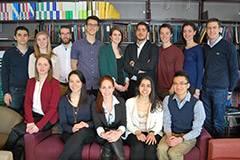An academic road trip
By Eleni Kanavas
A group of 14 undergraduate students in biomedical engineering from École Polytechnique de Montréal kicked off their March reading week by carpooling the six-hour drive to Toronto. Their mission was to visit biomedical institutions in pursuit of careers in research and industry.
Sunnybrook Research Institute (SRI) was the first stop on their itinerary and the only public sector institution.
Pierre To, an undergraduate student and vice-president external relations of the Biomedical Engineering Students’ Association at École Polytechnique de Montréal, helped organize the trip, which he says was highly recommended by former members of the association who visited SRI in 2011.
“Our goal this year is to increase awareness among students in regards to biomedical institutions outside of Montreal. It is in our best interest to learn what to expect on the job market and what kind of opportunities await us after our studies,” he said.
Dr. Kullervo Hynynen, director of Physical Sciences at SRI, welcomed the students. Merle Casci, coordinator of SRI’s Trainee Centre, organized and hosted the tour. The day started in the orthopaedic biomechanics lab where students met with Dr. Cari Whyne, director of the Holland Musculoskeletal Research Program. The lab focuses on clinical translational bioengineering research and aims to maximize function among patients who develop musculoskeletal disease or disability.
The group then headed to the facilities within SRI’s Centre for Research in Image-Guided Therapeutics. Inside the focused ultrasound lab, Dr. Meaghan O’Reilly, a scientist in Physical Sciences, explained how researchers are using noninvasive image-guided therapy with focused ultrasound to treat hard-to-reach targets in the body such as the brain, heart, uterine fibroids and bone metastases.
Casci then led the students to the device development lab, which includes the advanced machine shop. The state-of-the-art facility is equipped for the design, fabrication and testing of medical devices. It specializes in the manufacture of magnetic resonance imaging (MRI)-compatible devices, prototypes, custom-made parts and catheter-based devices, as well as 3-D computer-assisted design.
Michelle Demers, a second-year biomedical engineering student, and her peers said the highlight of the tour was the biomedical imaging research suite—saved for last on the tour. Inside the facility, research teams and clinician-scientists are conducting studies using computed tomography, MRI and focused ultrasound.
Dr. Charles Cunningham, a senior scientist in the Schulich Heart Research Program at SRI, discussed his research on contrast agents, molecular imaging and the use of the carbon-13 dynamic nuclear polarization polarizer for MR metabolic imaging of the heart and cancer.
“He was very good at summarizing his project and being able to let us understand the basis of his work was amazing,” said Demers.
The day wrapped up with a lunch where the group mingled with a few of SRI’s graduate students.
Dr. Peter Burns, a senior scientist in Physical Sciences at SRI and Chair of the department of medical biophysics at the University of Toronto, also dropped by to thank the students for their interest in SRI. He talked about U of T’s medical biophysics program and encouraged the students to pursue their studies further.
His advice: “Don’t neglect the possibility of doing graduate work. The essence of being a student in graduate work is to take something that’s a piece of research and make it your own. At the end of a PhD, you’re the expert!”






